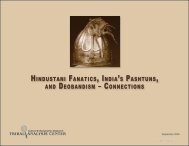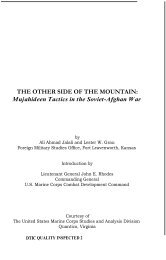Mahsuds and Wazirs - Tribal Analysis Center
Mahsuds and Wazirs - Tribal Analysis Center
Mahsuds and Wazirs - Tribal Analysis Center
Create successful ePaper yourself
Turn your PDF publications into a flip-book with our unique Google optimized e-Paper software.
<strong>Mahsuds</strong> <strong>and</strong> <strong>Wazirs</strong>; Maliks <strong>and</strong> Mullahs in CompetitionLower status tribes <strong>and</strong> sub-tribes are frequently the source of the problems experienced in the FATA, the Northwest Frontier Province, <strong>and</strong>even inside Afghanistan, as poorer tribes seek resources <strong>and</strong> status denied them by the more powerful, higher status tribes. In these situations, bothmullahs <strong>and</strong> maliks cooperate in leading their people into violent situations. In many ways, the government’s response to this general tendencytoward violence has worsened the violence. Government allowances to maliks are intended to ensure that the people led by the malik remain ongood behavior. These payments are calculated on a monthly basis, but are paid annually. Much like the mullahs who cannot attract supportersduring peaceful times, the maliks have good reason to ensure that trouble develops periodically – or their subsidies gradually erode. Kidnappingof officials, holding them for ransom or concessions, erection of roadblocks for the extortion of travelers, <strong>and</strong> the occasional sniping incident orbomb is part of a highly developed method of “tribal raiding.” Ahmad wrote, “To create a problem, control it, <strong>and</strong> terminate it is an acknowledged<strong>and</strong> highly regarded yardstick of political skill.” This tendency goes far beyond western Pakistan <strong>and</strong> has also been developed into an art form indistant Yemen where tourists are often kidnapped to force government concessions <strong>and</strong> road construction. This “raiding tendency” of the smaller,poorest tribes combined with jealousy of their more wealthy cousins are among the factors that allow creative, ambitious men to “self-ordain” <strong>and</strong>as mullahs, to lead their relatively naïve followers into jihad-like aggressive activity. Noor Mohammad, the “Waziristan mullah”, followed this precisepattern, but he focused his followers on the Mahsud tribe rather than the typical “foreign infidels.” Some form of “external threat” is essentialfor mullahs as they attempt to mobilize their followers. Atypically, Noor Mohammad chose his enemies poorly <strong>and</strong> his “proto-Taliban” movementfailed.Akbar Ahmad is correct with his view of the Waziristan Mullah’s revolt as “proto-Taliban-like,” but the context of the period is importantin underst<strong>and</strong>ing Noor Mohammad’s successful approach to creating a revolutionary change within the Wazir tribe. His movement was crushedin what Lord Curzon would describe as a “steam roller” when the Pakistani army moved against him in 1976. Significantly, this was three yearsbefore the Soviet Union intervened in Afghanistan to create a series of unstoppable, cascading events that culminated in the eventual evolution ofangry, frustrated Pashtuns into the Taliban Movement – that closely followed the pattern set by Noor Mohammad prior to 1976.By focusing the ire of the <strong>Wazirs</strong> on the Mahsud’s growing tribal power <strong>and</strong> wealth, Noor Mohammad was soon able to maneuver himselfinto a position from which he evolved into a symbol of Wazir honor, not an insignificant accomplishment in an honor-bound culture governed by awarrior’s code, Pashtunwali. Additionally, the Wazir tribes seem to suffer somewhat from an inferiority complex due to their relative isolation <strong>and</strong>their language, Wazirwola, 17 which is a dialect of Pashto, but is relatively unintelligible to both northern (Pakhtun) <strong>and</strong> southern (Pashtun) populations.These factors, physical <strong>and</strong> linguistic isolation, combined with a political situation that leaves them connected to both Pakistan <strong>and</strong> Afghanist<strong>and</strong>ue to the Afghan refusal to recognize the Dur<strong>and</strong> Line, make the Wazir tribes considerably more militant <strong>and</strong> aggressive when compared toother Pashtun tribes.Noor Mohammad also creatively followed the pattern established by the Hadda Mullah, the Haji of Turangzai, <strong>and</strong> Ghaffar Khan, the leaderof the Red Shirt Movement, by developing his base of supporters by his focus on education <strong>and</strong> establishing a madrassa. The students, Noor Mohammad’sTalibs, were soon moving throughout the region where they became his best organizers.Like his “revolutionary” predecessors, especially the Haji of Turangzai <strong>and</strong> Ghaffar Khan, Noor Mohammad soon introduced the concept of“Pakhtunistan” (Pashtunistan among southern Pashtuns) into his movement. This shift occurred following a visit to Noor Mohammad from ArbabSik<strong>and</strong>er Khan, the head of the National Awami Party <strong>and</strong> governor of Northwest Frontier Province. The Awami party was the political descendent17. http://en.wikipedia.org/wiki/Wazir_(Tribe)<strong>Tribal</strong> <strong>Analysis</strong> <strong>Center</strong>, 6610-M Mooretown Road, Box 159. Williamsburg, VA, 23188
















